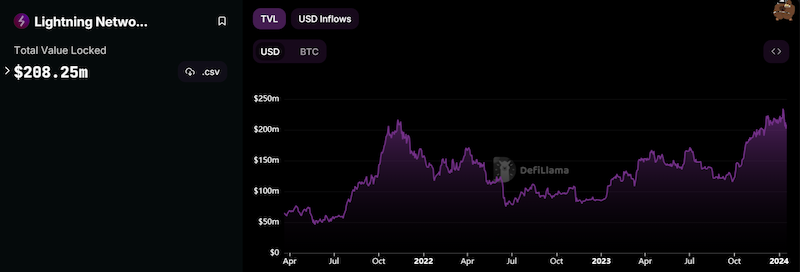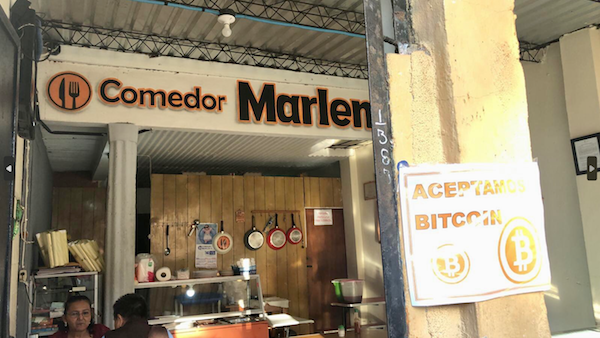Bitcoin may not be the go-to digital currency for most of the world’s 8.1 billion population today due to scaling limitations, but there’s a hoard of developers out there hoping that one day it will.
When Satoshi Nakamoto invented Bitcoin, it was meant to be a peer-to-peer electronic cash system. For a few years, that worked pretty well. But as the network grew larger and more valuable, most hodlers, which now include firms like MicroStrategy and BlackRock, just seem to want to hoard it all away.
Bitcoin payment naysayers point to the network’s slow transaction speeds and sky-high fees during periods of demand and note that its overall uptrend and volatility mean holders are more likely to salivate over future gains than spend their BTC.
“The one issue I still have with Bitcoin, it was meant to always be a currency,” Bloomberg ETF analyst Eric Balchunas told X Hall of Flame recently. “This is a real currency, and it went away. The price is volatile, and it is more like a commodity; it’s like gold.”
But the big question is: How can Bitcoin payments make a comeback?
Bitcoin’s golden years for payments
In the early years, at least, there was an unmistakable movement toward Bitcoin payments. BitPay reported in 2012 that over 1,000 merchants accepted Bitcoin through their service. Just one year later, it had already ballooned to 10,000 BTC-accepting merchants.
For a time, it seemed as if everyone was jumping on the Bitcoin payments bandwagon. I remember attending an online gambling conference in 2013 where one of the sponsors, a Bitcoin solutions company, moved $1 million worth of BTC to an attendee’s newly created Bitcoin wallet and back again in seconds. The crowd that had gathered around the phone gasped when they saw the enormous sum arrive — and for a negligible fee.
However, the wheels started to fall off around 2017 amid that year’s massive bull run. Bitcoin’s average transaction fee — the payment that incentivizes a Bitcoin miner to process and confirm a transaction — went from about $0.35 in January to nearly $55 in December 2017, according to data from BitInfoCharts.
A Bloomberg report around that time found that Bitcoin merchant acceptance was “low and getting lower,” with a Morgan Stanley analyst explaining that Bitcoin owners were “reluctant to use the cryptocurrency given its rate of appreciation” and that it was “way easier to trade speculatively than convince new merchants to accept the cryptocurrency.”
Attention shifted to an idea first proposed by Joseph Poon and Thaddeus Dryja in their 2015 white paper called The Bitcoin Lightning Network, a Bitcoin layer-2 network focused on scaling for payments.
Lightning Network scales to millions of TXs
Many of the traditional arguments against Bitcoin payments were seemingly solved after the Lightning Network was launched in 2018. However, it has developed its own problems.
The network is a layer-2 solution for Bitcoin built on top of the Bitcoin blockchain to solve the scaling problem with lightning-fast transactions and low fees.
Similar to setting up a tab at your local bar, each small Bitcoin transaction is accounted for on the layer-2 network. The Bitcoin mainnet and its high fees only come into play when one party decides to “settle the bar tab,” so to speak.
To utilize the Lightning Network, a Bitcoin user must first deposit a certain amount of Bitcoin onto the network — though the process can be simpler through a centralized Lightning Wallet provider. After that, they can transact back and forth with other users as long as there are enough funds. Transactions are practically instant and cost cents, not dollars.
David Marcus, CEO and co-founder of Lightspark — an enterprise gateway provider for the Lightning Network — believes that Bitcoin could become the “TCP/IP” for real-time value transport on the internet.
“The opportunity to reinvent how trillions of dollars of value move every day and make it always-on, low-cost, open, and real-time is incredibly exciting.”
Lightning Network has millions of issues
But while Lightning is great in theory, it is not so great in practice.
Some, including Bitcoin analyst and Ordinals proponent Eric Wall, argue that the complexity of the Lightning Network for ordinary users promotes the use of custodial wallets — particularly in a high-fee environment, which goes against the Bitcoin ethos of self-custody and decentralization.
Wall demonstrated exactly how difficult the Lightning Network could be in an excruciating thread over two days recently, in which Bitcoin evangelist Brad Mills, who’d lost a bet with Wall about ETH’s price, tried and failed numerous times to pay a simple Lightning invoice for $438.
The Lightning Network also suffers from a lack of merchant adoption and user awareness. Data from 1ML estimates there are currently 59,511 public payment channels and about 14,670 Lightning nodes on the network.
At present, there’s about $200 million in Bitcoin locked on the network (it hit an ATH of $234 million). In August 2023, prior to a big jump in the price of Bitcoin, just $78.2 million was publicly routed on the Lightning Network, according to financial services firm and Bitcoin tech company River. However, the 6.6 million transactions that month was a 1,212% increase over the same month in August 2021, so it is growing, albeit from a small base.

But to put the figures into perspective, credit card provider Visa averaged more than $1 trillion in payment volume per month last fiscal year, with over 4.3 billion cards issued worldwide.
And although it can theoretically handle millions of transactions per second, the River report suggested it was only doing around 2.5 transactions per second, fewer than Bitcoin’s on-chain average.
“The Lightning Network, despite its promise, faces capital inefficiencies and security concerns. These factors contribute to why, as we predicted, it’s not yet an effective payment layer for Bitcoin,” argues Eli Ben-Sasson, co-founder and president of StarkWare.
Instead, Ben-Sasson believes zero-knowledge proofs (or validity proofs, as he likes to call them) are the missing piece of the equation.
Zero-knowledge Bitcoin can make payments happen
Ben-Sasson is a household name in Ethereum scaling but was a Bitcoiner before ETH even existed. He discussed scaling Bitcoin with ZK tech with former Bitcoin core devs Greg Maxwell and Mike Hearn at the San Jose Bitcoin conference in 2013.
He believes upgrading Bitcoin to use ZK-proofs could address network congestion and high fees on the Bitcoin blockchain.
“Bitcoin has the potential to become a fantastic payment method, yet there is a big ‘but.’ It simply cannot achieve this unless it embraces the cryptography it needs to scale,” he argues.
“For as long as it continues to resist scaling solutions, it won’t become a viable payment method.”
A newly formed startup, ZeroSync — sponsored by StarkWare — has been developing ZK-proof-powered tools that allow users to validate the state of the Bitcoin network without downloading the blockchain or trusting a third party for verification.

There are also emerging Bitcoin L2 networks that have recently released white papers intending to scale Bitcoin using EVM and/or ZK tech. If they work out, it could certainly be a boon for Bitcoin payments.
But to scale Bitcoin properly with ZK-proofs would likely require a contentious hard fork to enable it to interact with the technology, and that seems unlikely to happen, says Ben-Sasson.
“I’ve been discussing STARK proofs since 2013. We’re showing every day what they can do in terms of scaling Ethereum, and they could also scale Bitcoin for mass use, including as a means of payment. This isn’t happening because of ideological conservatism in the Bitcoin community.”
Human Rights Foundation chief strategy officer Alex Gladstein tells Magazine he doesn’t see this taking off either, noting that ZK technology is unlikely to gain the support of a critical mass of the Bitcoin community as it “hurts the ability to audit the supply of Bitcoin” and makes transactions larger.
Gladstein doesn’t “think base-layer Bitcoin ends up being used for small payments,” but he does expect people to use Bitcoin as a “savings account” and as a settlement layer for businesses, nations and large institutions.
“For retail commerce or smaller payments, I think people make a tradeoff of some kind and use something like federated eCash, custodial Lightning, a neobank,” he adds.
So, if the Lightning Network is yet to take off and Bitcoiners aren’t keen on adding ZK-proofs, what other options are there?
Hal “Running Bitcoin” Finney had an idea
Early Bitcoin pioneer Hal Finney foresaw all of this happening and came up with his own solution. He postulated that “Bitcoin-backed banks” could issue their own digital currencies backed by Bitcoin.
“Bitcoin itself cannot scale to have every single financial transaction in the world be broadcast to everyone and included in the blockchain. There needs to be a secondary level of payment systems which is lighter weight and more efficient,” said Finney on the Bitcointalk forum in December 2010.
He saw Bitcoin becoming a reserve currency for banks, playing the same role as gold did between the mid-1940s and 1971. (Ever wondered WTF happened in 1971?)
“Bitcoin backed banks will solve these problems. They can work like banks did before nationalization of currency,” he added.

“I believe this will be the ultimate fate of Bitcoin, to be the ‘high-powered money’ that serves as a reserve currency for banks that issue their own digital cash. Most Bitcoin transactions will occur between banks to settle net transfers.”
Bitcoin transactions between private individuals will be rare, added Finney, who sadly passed away in 2014 as a legend in the Bitcoin community.
However, if the 10-year delay in approving spot Bitcoin ETFs, last year’s banking collapses and the much-discussed Operation Choke Point 2.0 in the United States are any indication, mainstream banks will face an uphill battle to even think about holding large swathes of Bitcoin.
Caitlin Long’s Custodia Bank, which seeks to be a bridge between crypto and the U.S. dollar payments system, is engaged in a court battle against the Federal Reserve for denying it a Fed master account. Its case is supported by Wyoming’s attorney general, and a decision is expected around March.
Does anyone want to pay with Bitcoin anyway?
It’s entirely possible that in developed economies, efficient electronic payment systems have undercut the demand for Bitcoin payments. Two studies from the U.S. Federal Reserve and the Reserve Bank of Australia found that just 2% of adults actually paid for something using cryptocurrency in 2022; a fraction of those used PayPal, QR or even Buy Now, Pay Later services.

But there are encouraging signs in developing economies. El Salvador, which famously passed the Bitcoin Law, saw a slow start to Bitcoin payments.
But things are slowly changing. In November, Bitcoin wallet and API platform Blink partnered with Distribuidora Morazán to launch a pilot program that will onboard 1,000 merchants to Bitcoin payments in 2024.
And a survey of 1,280 respondents by a researcher at the Central American University in El Salvador found that 12% of the local population used Bitcoin at least once in 2023 to pay for goods and services.

Meanwhile, recent data from BTC Map had recorded a 174% increase in Bitcoin-accepting vendors worldwide by the end of 2023, reaching 6,126 merchants.
Former Cointelegraph reporter Joe Hall, in a recent X post, noted there are pockets in the world, such as Cuba, where people prefer to deal in Bitcoin — volatility and all — rather than the local currency.
Cuba’s inflation rate was around 40%, while another pro-Bitcoin country, Venezuela, was as high as 439% in 2023. Keeping money in Bitcoin is a good alternative to fiat that’s rapidly losing value.

Maxwell Abbey, the public relations director of Wallet of Satoshi, tells Magazine that Bitcoin is more important than just a payment method to people hit by money printing and inflation.
“The important thing is that Bitcoin was birthed, and the human race now has access to something that has never been possible before: base money whose issuance is outside of the control of any individual, group or nation.”
“The irresistible temptation to debase the currency has been designed away and made impossible.”
Rise of the stablecoin
There are big threats to the adoption of Bitcoin payments in the form of stablecoin payments and central bank digital currencies. And poor people often turn to cheaper layer-1 blockchains like Tron. In emerging markets, Tether on Tron makes up 37% of stablecoin transactions.
But Gladstein sees stablecoins as only a temporary solution. “Ultimately, commerce, I think, will be denominated in BTC,” he argues.
Whatever happens, Bitcoin is here to stay, whether as “digital gold,” the world’s reserve currency, or as the backing for bank-issued currencies. And it’ll be used to pay for things, but to what extent remains an open question.
week.

The post Big Questions: Can Bitcoin payments rise again? appeared first on Cointelegraph Magazine.



 (@ercwl)
(@ercwl) 
